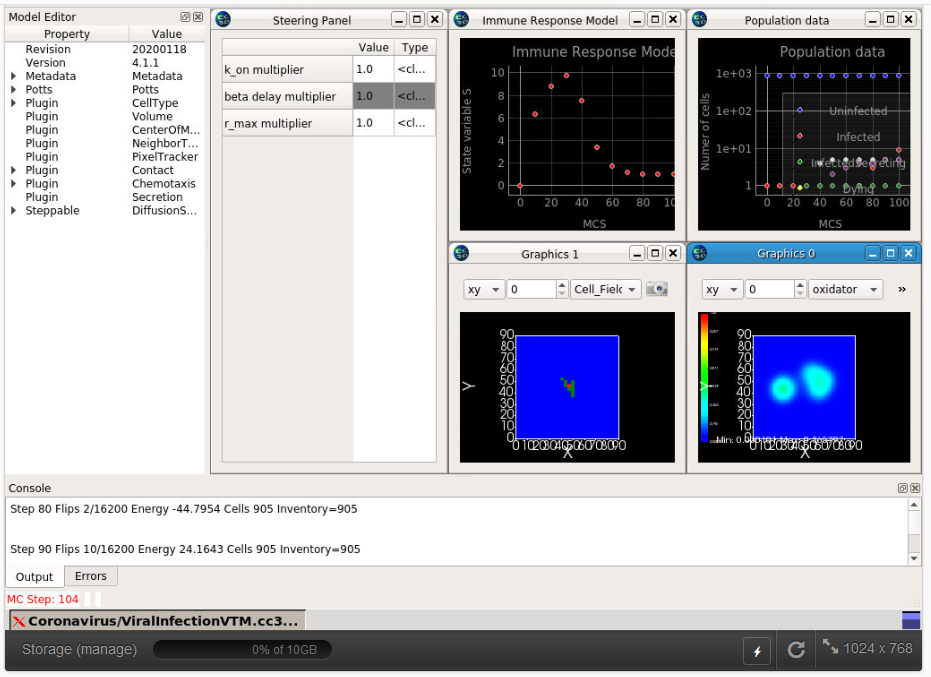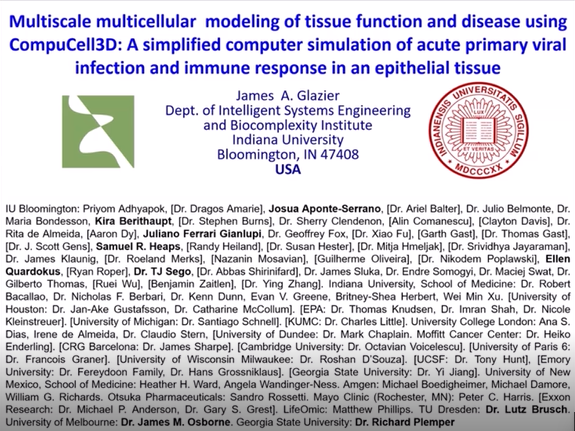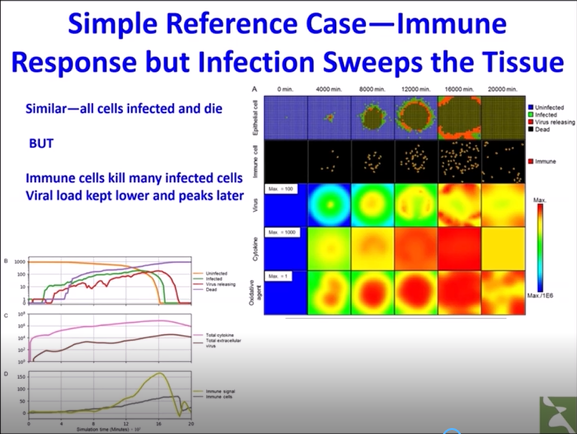NEW CC3D Version 4.3.1 (July 27 2022)
We are pleased to announce new version 4.3.1 of our software CompuCell3D. This release includes multiple improvements, speedups and and bug fixes. For more info, and to download the latest version, visit the Downloads page.
Improvements and new features
Improved DeveloperZone
- Faster Graphics
- Faster 2D Solvers with better multi-cpu scalability
- Ability to intercept cell inventory and cell type changes (as they occur) in Python
- Added ability to pause simulation at specified intervals
- Added message window support for any type of user output
- Fixed Parameter Scan
- Improved cell type color handling
- Improved Boolean network solver
- Multiple bug fixes
2022 Workshops:
The 2022 CompuCell3D workshop was July 31 - August 7. The course slides, videos, etc. are all linked from the Class Page
July 18–11: Network Modeling Virtual Summer School & Symposium at Reproducible Biomodels. YouTube videos are available here.
30 Years!
A thirtieth anniversary! Back on March 16th, 1992, François Graner and James Glazier submitted our very first paper on the Cellular Potts Model/Glazier-Graner-Hogeweg model to Physical Review Letters. We had no idea at that point that the method would still be used today and would be implanted in a dozen different modeling frameworks. As of today, that original paper (which appeared on September 28th, 1992) has been cited more than 1350 times. |
PhD Thesis of Josua Oscar Aponte-Serrano Ph.D.
We are pleased to share the PhD thesis of a recent graduate from the group: Josua Oscar Aponte-Serrano Ph.D., Indiana University (December 2021) Josua's thesis is available here. "Multicellular Multiscale Spatial Modeling of The Immune Response to Pathogens And Cancer"
Invitation to join the IMAG/MSM MULTISCALE MODELING AND VIRAL PANDEMICS Working Group
The invitation to join the IMAG/MSM working group is here.
Our Collaboratory Projects
We collaborate extensively with several other computational biology tools groups. In particular:
Mechanica
 Mechanica is an interactive particle based physics, chemistry and biology simulation environment, with a heavy emphasis on enabling users to model and simulate complex sub-cellular and cellular biological physics problems. Mechanica is part of the Tellurium project.
Mechanica is an interactive particle based physics, chemistry and biology simulation environment, with a heavy emphasis on enabling users to model and simulate complex sub-cellular and cellular biological physics problems. Mechanica is part of the Tellurium project.
Mechanica is designed first and foremost to enable users to work interactively with simulations -- so they can build, and run a simulation in real-time, and interact with that simulation whilst it's running. The goal is to create an SolidWorks type environment where users can create and explore virtual models of soft condensed matter physics, with a emphasis towards biological physics.
- Mechanica is a native compiled C++ shared library with a native and extensive Python API, that's designed to used from an iPython console (or via scripts of course).
Tellurium
 Tellurium allows you to model, simulate, and analyze biochemical systems using a single tool.
Tellurium allows you to model, simulate, and analyze biochemical systems using a single tool.
- Tellurium is a Python Environment for Reproducible Dynamical Modeling of Biological Networks
- Tellurium provides the interfacial code to convert between standard formats and utilize powerful libraries without requiring technical expertise, allowing you to focus on what’s important: building better models.
Tellurium also provides first-class support for exchangeability via COMBINE archives, allowing you to share your models and simulations with other tools.
NEWS: We have a new viral infection model paper!
"A Multiscale Multicellular Spatiotemporal Model of Local Influenza Infection and Immune Response", Sego, T. J., Mochan, E. D., Ermentrout, G. B., & Glazier, J. A. (2021). Journal of theoretical biology, 532, 110918. Advance online publication. Full text
NEWS: Our Covid-19 virtual tissue model is available for running on nanoHUB!
You can run our model in your browser, without any installations, at  (here).
(here).


For more info please visit our CC3D on nanoHUB page.
NEWS: CompuCell3D Multiscale, Virtual-Tissue Spatio-Temporal Modeling of Simulations of COVID-19 Infection, Viral Spread and Immune Response and Treatment Regimes
Simulations of tissue-specific effects of primary acute viral infections like COVID-19 are essential for understanding differences in disease outcomes and optimizing therapeutic interventions. In this two-part mini-workshop we present an open-source Python and CC3DML-scripted multiscale model and simulation of an epithelial tissue infected by a virus, a simplified cellular immune response and viral and immune-induced tissue damage and show how you can use it to model basic patterns of infection dynamics and antiviral treatment. Part I presents the model and teaches how to run it and to change model parameters for generating new biologically meaningful simulations. Part II teaches how to extend the model with additional images, graphics and file outputs, additional cell types, diffusive fields, cell behaviors and interactions and improved subcellular and immune-system models.
For more info and scheduling see here. The Part I and Part II videos are now available on YouTube.
We have prepared a YouTube video describing the model described in our preprint.
Multiscale multicellular modeling of tissue function and disease using CompuCell3D: A simplified computer simulation of acute primary viral infection and immune response in an epithelial tissue
This is a more detailed video presentation hosted by the Pacific Institute for the Mathematical Sciences on the use of CC3D in Covid-19 modeling.
(Click on this image to view the video.)


Call to Contribute: Collaborative Tissue Model Development to Mitigate the Coronavirus Pandemic
The rapidly evolving social and medical impact of COVID-19 requires equally rapid development of tools to predict, and ultimately ameliorate, the future course of the pandemic. Tools are needed to predict patient outcomes, to optimize the deployment of resources by medical providers, and to optimize therapy for infected individuals. Predictive computational simulations of the spread of the disease, and of the underlying biology that makes COVID-19 unique, are both essential. Our aim is to build cooperatively-developed, open-source multiscale model components that can predict various aspects of infection at molecular and tissue scales and inform higher-level models, and a framework to allow others to do so efficiently.
You can run our model online without any installations in https://nanohub.org/tools/cc3dcovid19.
COVID-19 Model Repository: Because of the urgency of the crisis, software development must be done in parallel and not sequentially as in normal scientific model development. As such, we are developing a model repository for the cooperative development of public, open-source molecular- and tissue-scale models and simulations of various infection events and health states associated with COVID-19. To support rapid parallel development, integration, and sharing of models and simulations, we are developing modeling and simulation tools specific to this project, as well as documentation tools and standards for rapid and consistent dissemination of repository contents. Please join us in our efforts to collectively mitigate the ongoing pandemic and future pandemics alike on GitHub. For more information, please contact us at <tjsego AT iu DOT edu>.
Model of Viral Tissue Infection: In support of parallel model development of tissue infection, the members of the Biocomplexity Institute are developing a multiscale computational model of viral tissue infection using CC3D. The model describes select interactions between generalized epithelial and immune cells and their extracellular environment associated with viral infection and immune response at the cellular and intracellular levels, and in the context of spatiotemporal dynamics. The model is a generic viral infection model, and our hope is to collaboratively develop it into a model of SARS-CoV-2 tissue infection and Covid-19 progression. As such, it is intended to serve as a base model for constructing and implementing more advanced models of targeted cellular- and intracellular-level phenomena in tissue after initial exposure. In its current state, it has not been formally peer-reviewed, and should not be used for patient diagnostics or predicting clinical outcomes. Rather, the model and its implementation can be used to develop and interrogate mechanistic hypotheses about the spread of a virus and how the interplay between viral spreading and immune response determine the outcome of the disease, such as:
- Why does the progression of the disease seem to be dependent on the initial viral exposure level?
- Why is the start time of symptoms and immune response so variable?
- What is the role of cytokine signaling in explaining immune response variability?
Model documentation and simulation files can be found in the project folder of our COVID-19 Model Repository. Please be advised that this is a rapidly evolving project, so model and simulation features are subject to change (even daily). For more information about how to contribute to, modify, or reuse the model and simulation, please contact us at <tjsego AT iu DOT edu>.
For information on recent modeling and repository developments, current development plans, and opportunities to contribute to current modeling and repository projects, please see our project page.
Latest News:
ONLINE CompuCell3D 15th User Training Workshop!
For more info on this completed workshop please visit the Workshop 20 pages.
New Papers using CompuCell3D Simulations have been published:
For a more complete list see our Publication Page.
Shape-velocity correlation defines polarization in migrating cell simulations
CompuCell3D simulations reproduce mesenchymal cell migration on flat substrates.
Fibroblast state switching orchestrates dermal maturation and wound healing
Computational Model of Secondary Palate Fusion and Disruption
Spheroid Formation of Hepatocarcinoma Cells in Microwells: Experiments and Monte Carlo Simulations
A Liver-Centric Multiscale Modeling Framework for Xenobiotics
Dynamics of cell aggregates fusion: Experiments and simulations
Synergy of cell–cell repulsion and vacuolation in a computational model of lumen formation
Advances in Modelling of Epithelial to Mesenchymal Transition
 CompuCell3D (Dev)
CompuCell3D (Dev)


